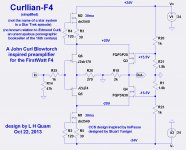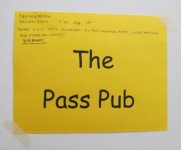Just wondering how successful the Realiser demo was? Any feedback from participants or from Jan Didden would be appreciated.😀
Very successful as far as I am concerned. People were generally flabbergasted that it could work so well. This was with calibration to my ears in SL's listening room so not optimized for other listeners, but still.
Same this weekend at RMAF. Totally convincing.
I switched back to 'just headphones', no processing, half way in the demo and people looked shocked.
I will try to get the company to design a stereo version (the A8 is 7.1 surround capable) with USB/S/PDIF input and sell it for $ 999 rather than the $ 3k+ of the A8 😉
Jan
That is the 'Salas low-voltage shunt regulator' available from member 'Tea-Bag' as the "BiB" PCB.
I know, what I meant was an integrated design, with psu and preamp circuit on the same board, as the dcb1 board. This would offer better integration and simpler wiring.
I was thinking about that - but probably won't make it a shunt reg... however the board would have a few extra pads so if you wanted to use a shunt in place of the other PSU, you could.
The major difference (other than the choice of FETs) is NO FEEDBACK.lhquam's TEASER F6C used Mosfets and a similar circuit structure.
Last edited:
I will try to get the company to design a stereo version (the A8 is 7.1 surround capable) with USB/S/PDIF input and sell it for $ 999 rather than the $ 3k+ of the A8 😉
Jan[/QUOTE]
If you can make this happen I'll take one. The realized really works. The only problem was that it made realize(ha ha) how terrible my headphones sound.
Jan[/QUOTE]
If you can make this happen I'll take one. The realized really works. The only problem was that it made realize(ha ha) how terrible my headphones sound.
The major difference (other than the choice of FETs) is NO FEEDBACK.
Pls look at post 5120 in the F6 amp thread. The schematic shows Teaser F6CC without global/loopfeedback [as you noted above; meaning like in diyF6]; but with local Schade or Pass Feedback from the output node to the MOSFET gates. The intent [if it works] is to impart triodish properties to the MOSFETs, and thus generate pseudo cascoded complementary SITs with the added bonus of using one main PSU.
One more video from Burning Amp with diyAudio member 6L6
who many guys appreciate for his excellent building guides
in Pass Camp high fidelity projects.
His talk :
https://www.youtube.com/watch?v=V5eOnuQJ3ww
Thank You very much Jim !
🙂 🙂
🙂 🙂
🙂 🙂
🙂 🙂
🙂

Best regards
who many guys appreciate for his excellent building guides
in Pass Camp high fidelity projects.
His talk :
https://www.youtube.com/watch?v=V5eOnuQJ3ww
Thank You very much Jim !
🙂
 🙂
🙂 🙂
🙂 🙂
🙂 🙂
🙂

Best regards
What your prefered evenement or project from BAF 2013 ?
My is 3 parts audio path amplifier🙂
Comments :
😀
Best regards
My is 3 parts audio path amplifier🙂
Comments :
😀
Best regards
Second part of Mr. Pass' presentation at BAF2013 shows a beautiful JFET preamp circuit. It's simple but very good and endlessly tweak-able.
Still, nobody mentions it here.
Guys, you are missing a seriously good preamp circuit...
Here is such a tweak. I have been working on a Blowtorch variant for several months. This is a simplified schematic. You will find more on the F4 thread. http://www.diyaudio.com/forums/pass-labs/97540-f4-power-amplifier-384.html#post3678887
Attachments
The variations in both Id and Vds in the output stage MOSFETs do not lend this circuit to low THD; because they are contra to the patent by Threshold's Corp. which taught STASIS; meaning contant current through and constant voltage across the transistor.Here is such a tweak. I have been working on a Blowtorch variant for several months. This is a simplified schematic. You will find more on the F4 thread. http://www.diyaudio.com/forums/pass-labs/97540-f4-power-amplifier-384.html#post3678887
Yes. The option of loop feedback to the joint gates to lower THD. Side effects are a low Zin [1K], and maybe triodizing the otherwise pentodish character of the parent amp.you can always cascode the cascode , even folded one
This output stage MOSFETs acts as a folded cascode. See the Blowtorch thread http://www.diyaudio.com/forums/solid-state/71189-john-curls-blowtorch-preamplifier.html (good luck wading thru it).The variations in both Id and Vds in the output stage MOSFETs do not lend this circuit to low THD; because they are contra to the patent by Threshold's Corp. which taught STASIS; meaning contant current through and constant voltage across the transistor.
The main differences between the Curllian-F4 and the Blowtorch are:
- 40 volt peak-to-peak output voltage
- single ended
I show some build results for the Curllian-F4 in the F4 thread: http://www.diyaudio.com/forums/pass-labs/97540-f4-power-amplifier-385.html#post3684975. I am not sure which thread to use for this.
Burning Amplifier Festival Pass Camp 2015
Hi Diyers
I was looking about BAF 2014 news and find this :
BurningAmp : The annual audio DIY event at Fort Mason, San Francisco CA for audiophiles who make their own equipment, components for amps, speakers, and parts.
Sadly is not happen this year snif...
but in 2015 BAF be twice more enjoyable

Hi Diyers
I was looking about BAF 2014 news and find this :
BurningAmp : The annual audio DIY event at Fort Mason, San Francisco CA for audiophiles who make their own equipment, components for amps, speakers, and parts.
Sadly is not happen this year snif...
but in 2015 BAF be twice more enjoyable

Attachments
- Status
- Not open for further replies.
- Home
- Amplifiers
- Pass Labs
- Burning Amplifier Festival Pass Camp 2013 News

